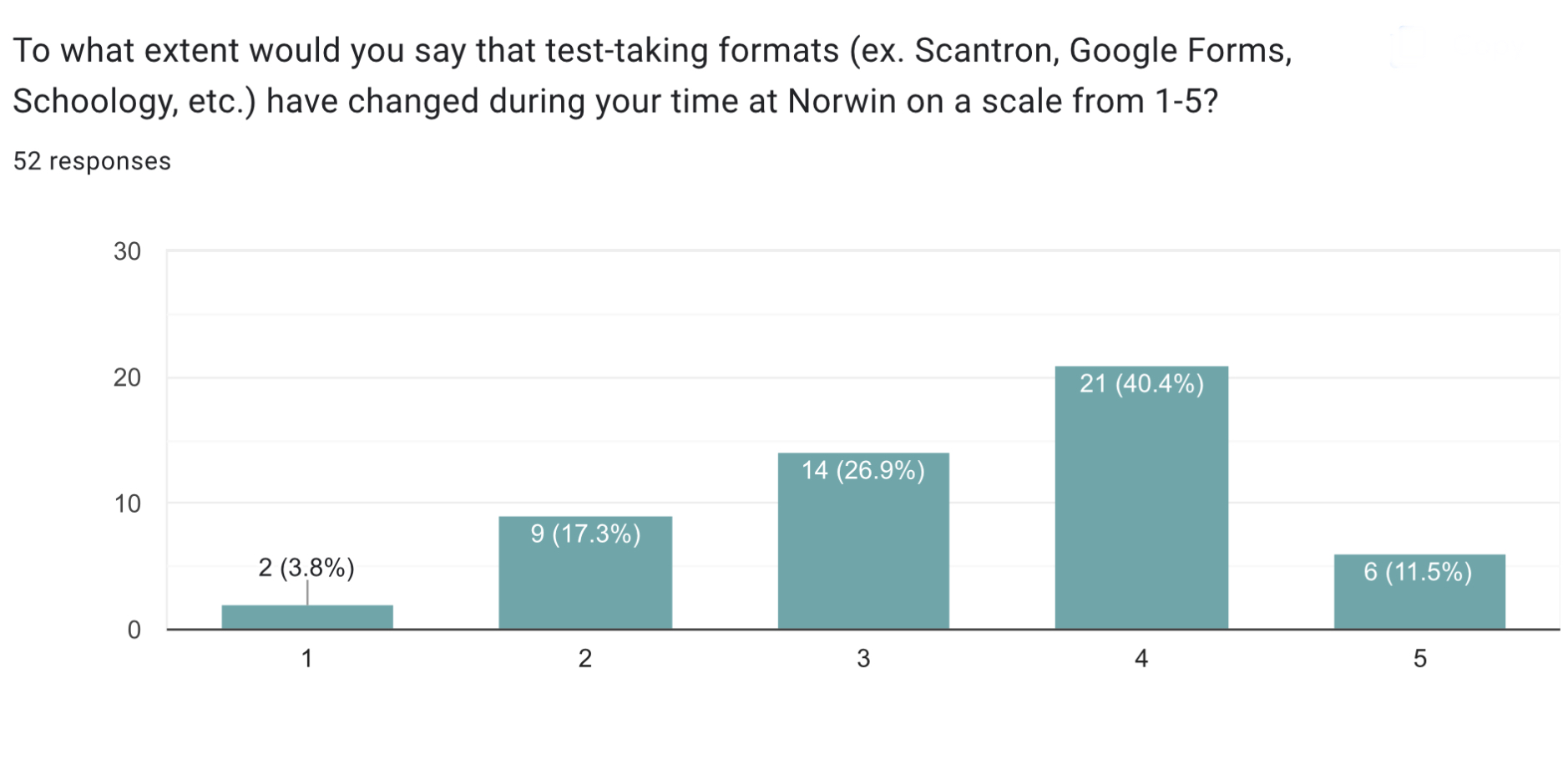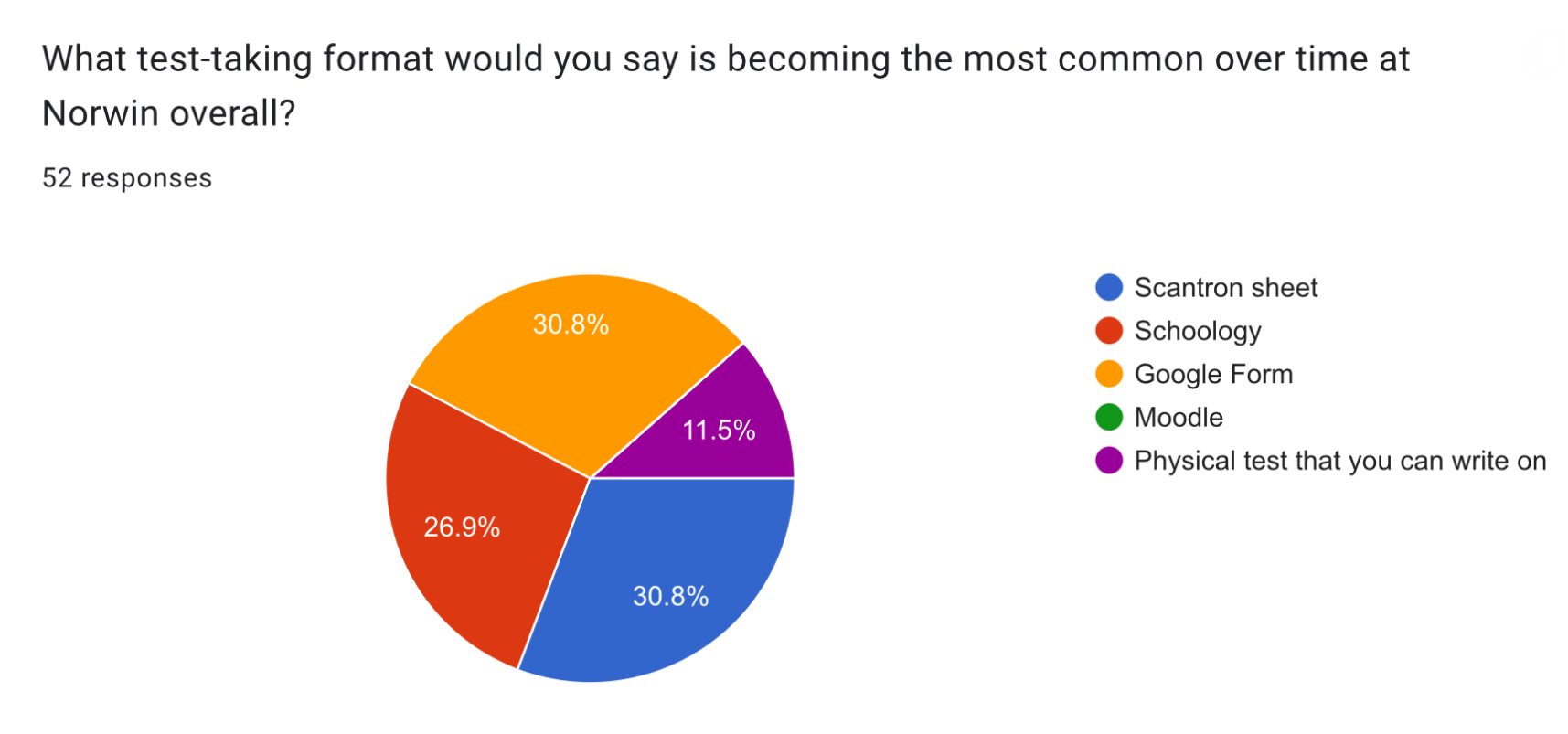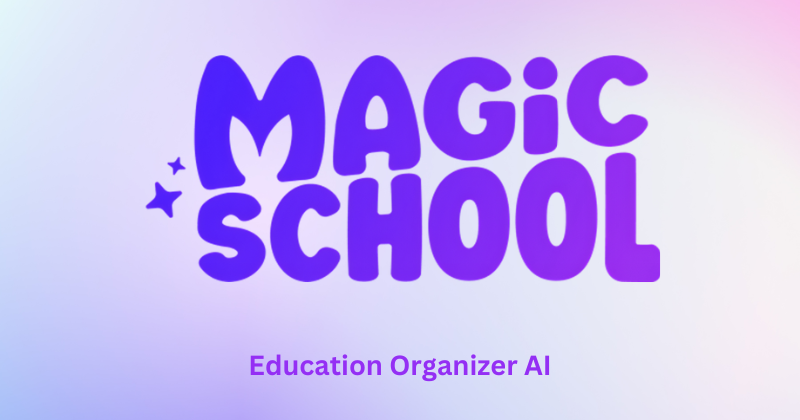
The day of your big exam has arrived. You have reviewed the material and achieved a restful night of sleep. When you finally enter the classroom to take your test, you do not get out a pencil or other writing tool in preparation for your assessment. Instead, you reach into your bag for your freshly charged iPad where your test awaits you.
As technology has become more accessible in the classroom, testing uses a combination of both physical and digital formats. Norwin is no exception; a test might be administered through a Scantron sheet, Google Form, Schoology exam, or another format. The distribution of school-provided iPads has increased the options for testing formats. For better or for worse, exam formats have experienced a noticeable change.
According to a recent random intro to journalism poll of over 50 Norwin students, 40 percent of students rated the amount of change that iPads have caused on test formats as a “5 out of 5” being the highest score on impact impact of iPads on assessments.
“At least in my class, a lot is done on the iPads,” Mrs. Danae Brentzel-Martina, Honors English 10 teacher at the high school, said. “And we’re still doing multiple choice questions — we can still do short answer questions — but it is interesting how kids interact with the test in ways that are different than when they had a pencil-and-paper test that they could write on, versus a Schoology test where they can’t necessarily annotate questions or make choices as easily. It’s interesting how it’s changing their thinking process as they’re testing.”

Teachers have used iPads to varying extents in their classrooms. The iPads have provided a means for students to take online exams that had not been available before. Now that there are more options, teachers have to make the choice as to what formats they want to use.
“When I’m looking at how I’m testing my students, I’m looking at what I am expecting them to show me that they are able to do or to know and what’s the best medium for them to be able to show me that information,” said Brentzel-Martina. “And sometimes it is also what is the way that I can get the information back to them the most quickly as far as how they did on that particular assessment — in which case something like Schoology is going to be way faster.”
There is not one test format used exclusively in Norwin classrooms. Different formats are used differently and to different extents; this variability is reflected in the way that students view trends in test-taking formats at Norwin.
Of the students polled, 31 percent think that scantron sheets are becoming the most common at Norwin, and 31 percent think that Google Forms are becoming the most common format. However, the polled students were split fairly evenly. For example, the Schoology format was chosen as becoming the most common by 27 percent of those polled.

Each student is affected differently by the format of any given test. Some have preferences for one format over another while others do not have as much of an opinion. Due to the variation in format, some find that they need to prepare for tests differently or go into a test knowing that they will have certain struggles based on the format.
“Even though the actual test itself is the same, the format can lead to different approaches just with how confident one feels on the test or how organized they are,” Adayah Ganster, a polled Norwin sophomore, said. “If a test is on an iPad versus any paper test you won’t know when other classmates turn it in which can make finishing the test less stressful. If a test is on paper you can cross out answers and layout and edit your work easier.”
Conversely, some students do not approach tests differently depending on format. They find that tests are fairly consistent regardless of format because the exam still covers the same material.
“I prepare for every test the same, regardless of the format because the content is the same on all,” said Olivia George, a polled freshman.
Standardized tests are not exempt from recent format changes. While tests like the SAT have traditionally been hard-copy exams, many standardized assessments are transitioning to online formats. Starting in the Spring of 2024, all SAT exams will be administered digitally.
According to the College Board, 80 percent of students who took the piloted online version of the SATs in 2021 found the test to be less stressful than the hard copy version.
Online standardized assessments have started being administered at Norwin. In the fall of 2023, Norwin juniors and some sophomores took the online PSATs. Some students like the prospect of taking standardized tests digitally.
“The essay questions make my hand cramp a lot, so having an online test that will have long essay questions is just better,” sophomore Gianna Lajevic said on the topic of online standardized tests.
While some students like the online format, others prefer a physical test. Some common reasons for this preference were eye strain or a lack of being able to easily or intuitively annotate questions in a digital format.
“I feel like online standardized tests limit my ability to think through the questions,” Grace Fleckenstein, a Norwin junior said. “I am more worried about not being able to highlight, underline, or cross out answers, therefore my brain automatically focuses on the general idea of the question instead of specifically what the question is asking.”
Test-taking formats of standardized tests do not only impact students; teachers also often take the test format into consideration when preparing students for standardized assessments. While the SATs and PSATs are now going to be digital, tests like the Keystones and AP exams are still administered through physical test copies. The format of the English 10 Keystone causes Mrs. Brentzel-Martina to have pencil-and-paper test pratice in her Honors English 10 class.
“I could assign that exact same prompt as a Google Doc,” said Brentzel-Martina. “I could assign that exact same prompt in Writable. I will actually take a copy of the Keystone and I will put your prompt in the same font and everything — it’s the exact same number of lines, the exact same spacing — so that when you are taking the pencil-and-paper test it feels exactly like what we’ve been doing in class.”
Currently, Norwin is in a transition period when it comes to test-taking formats. Teachers are discovering what works and what does not for their students and their teaching preferences. While the digital format that will become the most common is still unclear, one thing is for certain: technology in testing is not going away any time soon.
“My favorite format for a test in my class is the one that is going to give me the most authentic snapshot of what my students are able to do with the information they’ve learned and that particular time, so it just depends on whatever the lesson happens to be,” said Brentzel-Martina.














